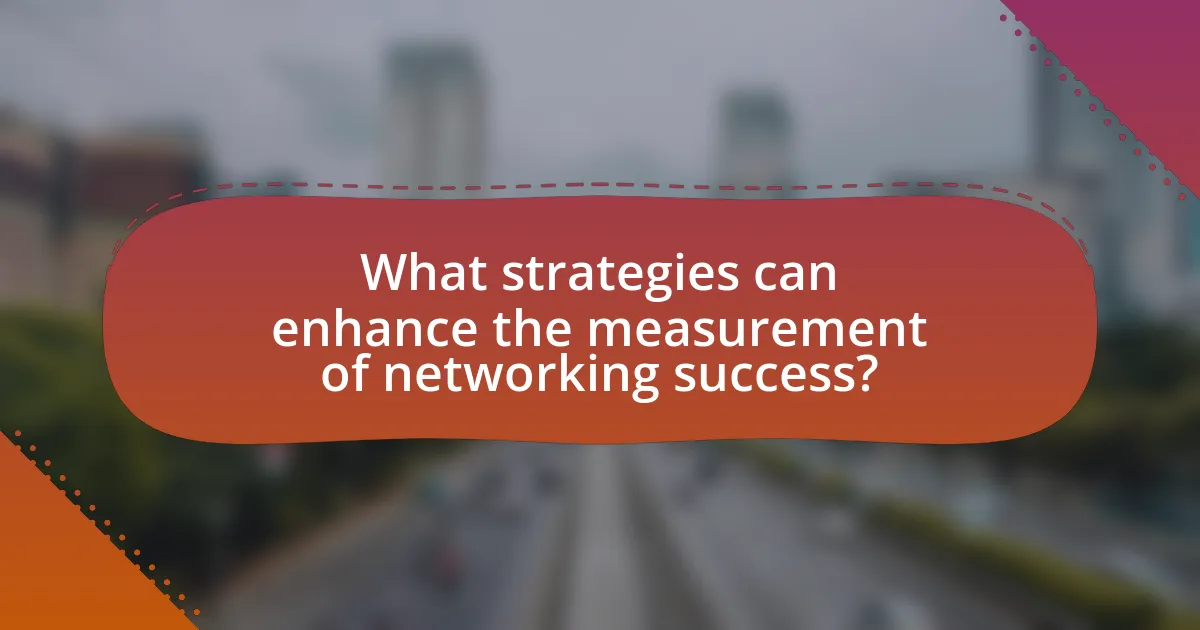The article focuses on measuring the success of local networking efforts, emphasizing the importance of establishing meaningful connections and generating tangible outcomes. Key metrics for evaluation include the number of new connections, the quality of those relationships, engagement levels, and conversion rates into business opportunities. It discusses the significance of setting specific networking goals aligned with business objectives, utilizing tools such as CRM systems and social media analytics for tracking success, and implementing feedback mechanisms to assess effectiveness. Additionally, it highlights common pitfalls to avoid and best practices to enhance networking outcomes, ensuring a comprehensive understanding of how to effectively measure and improve networking strategies.

How can you define the success of your local networking efforts?
The success of local networking efforts can be defined by the number of meaningful connections established and the tangible outcomes generated from those relationships. Metrics such as the increase in referrals, collaborations, or business opportunities directly linked to networking activities serve as concrete indicators of success. For instance, a study by the Harvard Business Review found that 70% of jobs are found through networking, highlighting the effectiveness of building relationships in achieving professional goals. Additionally, tracking follow-up meetings or partnerships formed as a result of networking can provide further evidence of successful engagement.
What metrics can be used to evaluate networking success?
Metrics used to evaluate networking success include the number of new connections made, the quality of those connections, engagement levels, and the conversion rate of connections into business opportunities. The number of new connections reflects the reach of networking efforts, while the quality of connections can be assessed through follow-up interactions and the relevance of those connections to one’s goals. Engagement levels can be measured by tracking interactions, such as meetings or referrals generated from the network. Finally, the conversion rate indicates how many connections lead to tangible outcomes, such as sales or partnerships, providing a clear measure of the effectiveness of networking activities.
How do you measure the number of connections made?
To measure the number of connections made, track the total interactions with individuals during networking events or through digital platforms. This can be quantified by counting the number of business cards exchanged, follow-up emails sent, or connections made on social media platforms like LinkedIn. For instance, a study by the Harvard Business Review indicates that effective networking can lead to a 50% increase in professional opportunities, highlighting the importance of quantifying these interactions to assess networking success.
What role does the quality of connections play in success measurement?
The quality of connections significantly influences success measurement by determining the depth and effectiveness of relationships within a network. High-quality connections foster trust, collaboration, and support, which are essential for achieving personal and professional goals. Research indicates that strong ties, characterized by frequent interactions and emotional closeness, lead to greater opportunities and resources, enhancing overall success. For instance, a study by Granovetter (1973) in “The Strength of Weak Ties” highlights that while weak ties can provide access to new information, strong ties are crucial for support and motivation, ultimately impacting success metrics.
Why is it important to set specific goals for networking?
Setting specific goals for networking is crucial because it provides direction and clarity in building professional relationships. Clear objectives enable individuals to identify the right contacts, tailor their communication strategies, and measure their networking success effectively. Research indicates that goal-setting enhances performance by 20-25%, as it focuses efforts and resources on achieving defined outcomes. Specific goals also facilitate accountability, allowing individuals to track progress and adjust strategies as needed, ultimately leading to more meaningful connections and opportunities.
What types of goals should you consider for effective networking?
For effective networking, consider setting goals that focus on relationship building, knowledge sharing, and opportunity creation. Relationship building goals aim to establish meaningful connections with individuals in your industry, enhancing trust and collaboration. Knowledge sharing goals involve exchanging insights and expertise, which can lead to personal and professional growth. Opportunity creation goals focus on identifying and pursuing new business or career opportunities through your network. Research indicates that professionals who actively engage in networking with clear goals are 70% more likely to achieve their desired outcomes, highlighting the importance of goal-oriented networking strategies.
How can you align your networking goals with your business objectives?
To align your networking goals with your business objectives, first, clearly define your business objectives, such as increasing sales, expanding market reach, or enhancing brand awareness. Then, identify networking goals that directly support these objectives, like connecting with potential clients, industry influencers, or strategic partners. For instance, if your objective is to increase sales by 20% in the next year, your networking goal could be to attend specific industry events where potential clients are present. Research shows that 70% of jobs are found through networking, highlighting the importance of targeted connections in achieving business growth. By ensuring that your networking efforts are strategically focused on individuals and groups that can help fulfill your business objectives, you create a direct link between the two, enhancing the effectiveness of your networking activities.
What tools can assist in measuring networking success?
Tools that can assist in measuring networking success include social media analytics platforms, customer relationship management (CRM) software, and networking event feedback surveys. Social media analytics platforms, such as Hootsuite and Sprout Social, provide insights into engagement metrics, audience growth, and content performance, allowing users to assess the effectiveness of their networking efforts online. CRM software, like Salesforce and HubSpot, tracks interactions and relationships with contacts, enabling users to evaluate the impact of networking on business outcomes, such as lead generation and sales conversions. Networking event feedback surveys, conducted through tools like SurveyMonkey or Google Forms, gather participant insights on the value and effectiveness of networking events, providing quantitative data to measure success.
How can social media analytics contribute to your evaluation?
Social media analytics can significantly enhance your evaluation by providing measurable insights into audience engagement and content performance. These analytics track metrics such as likes, shares, comments, and follower growth, allowing you to assess which strategies resonate most with your target audience. For instance, a study by Hootsuite found that businesses using social media analytics reported a 30% increase in engagement rates, demonstrating the effectiveness of data-driven decision-making. By analyzing this data, you can refine your networking efforts, optimize content, and ultimately improve your local outreach strategies.
What role do CRM systems play in tracking networking efforts?
CRM systems play a crucial role in tracking networking efforts by centralizing and organizing contact information, interactions, and follow-ups with networking connections. These systems enable users to log details about meetings, phone calls, and emails, which helps in maintaining a comprehensive history of relationships. For instance, a study by Nucleus Research found that CRM systems can increase sales productivity by up to 14% through better tracking of customer interactions. This data-driven approach allows businesses to analyze the effectiveness of their networking strategies, identify key contacts, and tailor their outreach efforts accordingly.

How can you assess the impact of your networking activities?
To assess the impact of your networking activities, track specific metrics such as the number of new connections made, referrals received, and opportunities generated. These metrics provide quantifiable data that reflects the effectiveness of your networking efforts. For instance, a study by the Harvard Business Review found that 70% of jobs are found through networking, indicating that successful networking can lead to significant career advancements. Additionally, monitoring follow-up interactions and the conversion rate of leads into actual business can further demonstrate the tangible benefits of your networking activities.
What feedback mechanisms can you implement to gauge success?
To gauge success in local networking efforts, implement mechanisms such as surveys, follow-up interviews, and social media analytics. Surveys can collect quantitative and qualitative data from participants about their experiences and perceived value of networking events. Follow-up interviews provide deeper insights into individual perspectives and can highlight areas for improvement. Social media analytics track engagement metrics, such as likes, shares, and comments, which reflect the reach and impact of networking activities. These methods are validated by research indicating that feedback from participants directly correlates with the effectiveness of networking initiatives, allowing for data-driven adjustments to enhance future efforts.
How can surveys help in understanding the effectiveness of your networking?
Surveys can help in understanding the effectiveness of networking by collecting direct feedback from participants about their experiences and perceptions. This feedback allows individuals to assess the quality of connections made, the relevance of interactions, and the overall impact on their professional goals. For instance, a survey might reveal that 70% of respondents found valuable partnerships through networking events, indicating a high level of effectiveness. Additionally, surveys can identify areas for improvement, such as the need for more targeted networking opportunities or better follow-up strategies, thereby providing actionable insights to enhance future networking efforts.
What are the benefits of conducting follow-up interviews with contacts?
Conducting follow-up interviews with contacts enhances relationship building and provides deeper insights into networking effectiveness. These interviews allow for clarification of previous discussions, fostering stronger connections and trust. Additionally, they enable the gathering of feedback on services or products, which can inform improvements and adaptations. Research indicates that maintaining relationships through follow-ups can increase referral rates by up to 70%, demonstrating their impact on networking success.
How do you analyze the return on investment (ROI) of networking?
To analyze the return on investment (ROI) of networking, one must quantify the benefits gained from networking activities against the costs incurred. This involves calculating the total revenue generated from networking connections, such as new clients or partnerships, and comparing it to the total expenses, including time spent, event costs, and travel expenses. For instance, if a networking event costs $500 and results in $5,000 in new business, the ROI would be calculated as ($5,000 – $500) / $500, resulting in an ROI of 9, or 900%. This method provides a clear financial metric to evaluate the effectiveness of networking efforts.
What factors should be considered when calculating networking ROI?
When calculating networking ROI, key factors include measurable outcomes, costs associated with networking activities, and the time invested. Measurable outcomes encompass tangible benefits such as new clients, increased sales, or enhanced brand awareness, which can be quantified to assess the financial return. Costs involve expenses related to events, travel, and materials, which must be accounted for to determine net gain. Time invested refers to the hours spent networking, as this can impact overall productivity and opportunity costs. By analyzing these factors, businesses can accurately evaluate the effectiveness of their networking efforts and make informed decisions about future investments.
How can you compare networking costs against tangible benefits?
To compare networking costs against tangible benefits, quantify both the expenses incurred and the measurable outcomes achieved. Networking costs include expenses such as event fees, travel, and time invested, while tangible benefits can be assessed through metrics like increased sales, new partnerships, or enhanced brand visibility. For instance, if a business spends $1,000 on networking events and subsequently generates $5,000 in new contracts, the return on investment (ROI) can be calculated as a 500% increase, demonstrating a clear financial benefit that outweighs the costs. This method allows for a straightforward evaluation of the effectiveness of networking efforts.

What strategies can enhance the measurement of networking success?
To enhance the measurement of networking success, implementing specific metrics such as tracking referral rates, follow-up engagement, and conversion rates is essential. These metrics provide quantifiable data that can indicate the effectiveness of networking efforts. For instance, a study by the Harvard Business Review found that professionals who actively track their networking outcomes are 50% more likely to achieve their business goals. Additionally, utilizing tools like CRM systems can help in systematically recording interactions and outcomes, allowing for better analysis of networking effectiveness over time.
How can you create a structured follow-up plan?
To create a structured follow-up plan, first outline specific objectives for your follow-up efforts, such as maintaining relationships or converting leads into clients. Next, establish a timeline for follow-ups, determining when and how often to reach out, which can be based on the nature of the initial interaction. Additionally, categorize your contacts based on their engagement level and tailor your communication accordingly, ensuring that each follow-up is relevant and personalized. Finally, utilize tools like CRM software to track interactions and set reminders, which enhances organization and accountability in your follow-up process. This structured approach increases the likelihood of successful networking outcomes, as studies show that timely and personalized follow-ups can significantly improve relationship-building and conversion rates.
What steps should be included in an effective follow-up strategy?
An effective follow-up strategy should include the steps of timely communication, personalized outreach, tracking interactions, and setting clear next steps. Timely communication ensures that the follow-up occurs soon after the initial interaction, ideally within 24 to 48 hours, which increases the likelihood of engagement. Personalized outreach involves tailoring messages to the individual, referencing specific points from previous conversations to demonstrate attentiveness and build rapport. Tracking interactions, such as noting responses and engagement levels, allows for better understanding of what resonates with contacts, facilitating more effective future communications. Finally, setting clear next steps provides direction for the relationship, whether it involves scheduling a meeting, sharing additional resources, or outlining future collaboration opportunities. These steps are supported by research indicating that timely and personalized follow-ups significantly enhance relationship-building and networking success.
How often should you engage with your network after initial contact?
Engage with your network every 4 to 6 weeks after initial contact. This frequency allows for maintaining relationships without overwhelming your contacts. Research indicates that consistent engagement, such as sharing relevant articles or checking in, strengthens professional ties and increases the likelihood of referrals or collaborations. A study by the Harvard Business Review found that regular communication can significantly enhance networking effectiveness, leading to better opportunities and support within professional circles.
What best practices can improve your networking outcomes?
To improve networking outcomes, individuals should prioritize building genuine relationships, actively listening, and following up consistently. Establishing authentic connections fosters trust and collaboration, which are essential for effective networking. Active listening enhances understanding and engagement, allowing for more meaningful interactions. Consistent follow-up, such as sending a thank-you note or scheduling a follow-up meeting, reinforces connections and demonstrates commitment. Research indicates that 70% of professionals attribute their success to networking, highlighting the importance of these best practices in achieving favorable networking results.
How can you leverage local events for better networking results?
To leverage local events for better networking results, actively participate in community gatherings, workshops, and seminars relevant to your industry. Engaging in these events allows you to meet potential clients, partners, and industry leaders face-to-face, fostering stronger relationships. According to a study by the Event Marketing Institute, 84% of participants in live events believe that in-person interactions are crucial for building lasting business relationships. By preparing an elevator pitch, exchanging business cards, and following up with new contacts post-event, you can enhance your networking effectiveness and track your connections’ progress over time.
What role does consistency play in successful networking?
Consistency is crucial in successful networking as it fosters trust and reliability among connections. When individuals consistently engage with their network, whether through regular communication, attending events, or following up on discussions, they reinforce their presence and commitment. Research indicates that consistent interactions can lead to stronger relationships, as people are more likely to remember and value those who maintain regular contact. For instance, a study published in the Journal of Business and Psychology found that consistent networking behaviors significantly enhance perceived trustworthiness and relationship quality, which are essential for effective networking outcomes.
What common pitfalls should you avoid in measuring networking success?
Common pitfalls to avoid in measuring networking success include relying solely on quantitative metrics, neglecting qualitative feedback, and failing to establish clear objectives. Relying only on numbers, such as the number of contacts made, can overlook the depth of relationships formed, which is crucial for networking success. Neglecting qualitative feedback, such as personal testimonials or insights from peers, can lead to an incomplete understanding of the impact of networking efforts. Additionally, without clear objectives, it becomes challenging to assess whether networking activities are aligned with desired outcomes, leading to misinterpretation of success. These pitfalls can hinder effective evaluation and improvement of networking strategies.
How can unrealistic expectations hinder your networking evaluation?
Unrealistic expectations can significantly hinder your networking evaluation by distorting your perception of success and progress. When individuals set unattainable goals, such as expecting immediate results or a high volume of connections, they may overlook meaningful relationships and incremental improvements. Research indicates that over 70% of professionals report feeling disappointed when their networking efforts do not meet inflated expectations, leading to disengagement and reduced motivation. This disconnect can result in a failure to accurately assess the value of existing connections and opportunities, ultimately impairing the effectiveness of networking strategies.
What mistakes should you watch out for when tracking networking metrics?
When tracking networking metrics, common mistakes include failing to define clear objectives, neglecting data consistency, and overlooking qualitative insights. Defining clear objectives is crucial because it ensures that the metrics collected align with specific goals, such as increasing referrals or enhancing brand awareness. Neglecting data consistency can lead to inaccurate comparisons over time, as inconsistent data collection methods may skew results. Additionally, overlooking qualitative insights, such as personal connections and relationship quality, can result in a narrow understanding of networking effectiveness. These mistakes can hinder the ability to accurately assess and improve networking efforts.




